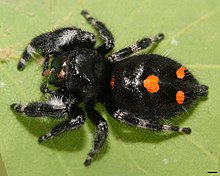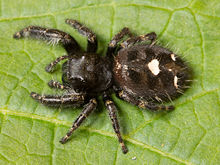| Phidippus audax | |
|---|---|

| |
| Female in Columbia County, Florida | |
| Scientific classification | |
| Domain: | Eukaryota |
| Kingdom: | Animalia |
| Phylum: | Arthropoda |
| Subphylum: | Chelicerata |
| Class: | Arachnida |
| Order: | Araneae |
| Infraorder: | Araneomorphae |
| Family: | Salticidae |
| Subfamily: | Salticinae |
| Genus: | Phidippus |
| Species: | P. audax
|
| Binomial name | |
| Phidippus audax (Hentz, 1845)
| |

| |
| Synonyms | |


Phidippus audax, the Bold jumper or Daring jumping spider, is a common species of spider belonging to the genus Phidippus, a group of jumping spiders easily identified by their large eyes and their iridescent chelicerae.[1][2] Like all jumping spiders, they have excellent stereoscopic vision that aids them in stalking prey and facilitates visual communication with potential mates during courting.[1] Bold jumping spiders are native to North America and have been introduced to Hawaii, Nicobar Islands, Azores, and the Netherlands.[3][4][5] They are typically black with a distinct white triangle on their abdomen.[3]
Bold jumping spiders are solitary carnivores that use their highly specialized eyesight to actively hunt and stalk prey.[3] They prey on a variety of insects and non-insect terrestrial arthropods such as caterpillars, dragonflies, grasshoppers, and other spiders.[3][6][2] They are one of the most common spiders found in agricultural areas and have been studied to determine their impact on crop pest populations.[6] Unlike most spiders, bold jumpers do not build webs to catch prey.[6]
These spiders can be found in temperate climates in a variety of terrestrial habitats including grasslands, chaparrals, open woodlands, and agricultural fields.[3][4][2] The bold jumper is one of the most commonly occurring spider species within its range and is often found living in close proximity to humans.[2][7] Bites from Phidippus audax are rare but may occur if they feel threatened or are mishandled.[2][7]
- ^ a b Jackson, R., & Richman, D. (1992). A review of the ethology of jumping spiders Araneae Salticidae. Bulletin of the British Arachnological Society 9.http://peckhamia.com/hosted/Richman%20Jackson%201992%20A%20review%20of%20the%20ethology%20of%20jumping%20spiders.pdf
- ^ a b c d e Edwards, G. B. (1980). Taxonomy, ethology, and ecology of Phidippus (Araneae: Salticidae) in eastern North America. University of Florida.
- ^ a b c d e Hammond, George; Knight, Katie. "Phidippus audax". Animal Diversity Web. Retrieved December 4, 2022.
- ^ a b Edwards, G.. (2004). "Revision of the Jumping Spiders of the Genus Phidippus (Araneae: Salticidae)" Occasional Papers of the Florida State Collection of Arthropods Volume 11. Collect. Arthropods. 11.https://www.fdacs.gov/ezs3download/download/25106/516022/Media/Files/Plant-Industry-Files/Edwards_2004_Revision_Phidippus.pdf
- ^ "NMBE - World Spider Catalog". wsc.nmbe.ch. Retrieved December 4, 2022.
- ^ a b c Bailey, Charles L (January 28, 1969). LIFE HISTORY OF THE SPIDER, LIFE HISTORY OF PHIDIPPUS AUDAX (HENTZ), IN RELATION TO BIOLOGICAL CONTROL OF GRAIN SORGHUM INSECTS (PDF) (Thesis). Oklahoma State University.
- ^ a b "Phidippus audax". escholarship.org. Retrieved December 4, 2022.